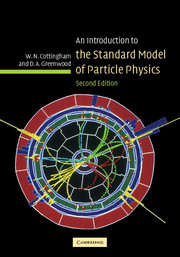Book contents
- Frontmatter
- Contents
- Preface to the second edition
- Preface to the first edition
- Notation
- 1 The particle physicist's view of Nature
- 2 Lorentz transformations
- 3 The Lagrangian formulation of mechanics
- 4 Classical electromagnetism
- 5 The Dirac equation and the Dirac field
- 6 Free space solutions of the Dirac equation
- 7 Electrodynamics
- 8 Quantising fields: QED
- 9 The weak interaction: low energy phenomenology
- 10 Symmetry breaking in model theories
- 11 Massive gauge fields
- 12 The Weinberg–Salam electroweak theory for leptons
- 13 Experimental tests of the Weinberg–Salam theory
- 14 The electromagnetic and weak interactions of quarks
- 15 The hadronic decays of the Z and W bosons
- 16 The theory of strong interactions: quantum chromodynamics
- 17 Quantum chromodynamics: calculations
- 18 The Kobayashi–Maskawa matrix
- 19 Neutrino masses and mixing
- 20 Neutrino masses and mixing: experimental results
- 21 Majorana neutrinos
- 22 Anomalies
- Epilogue
- Appendix A An aide-mémoire on matrices
- Appendix B The groups of the Standard Model
- Appendix C Annihilation and creation operators
- Appendix D The parton model
- Appendix E Mass matrices and mixing
- References
- Hints to selected problems
- Index
1 - The particle physicist's view of Nature
Published online by Cambridge University Press: 05 September 2012
- Frontmatter
- Contents
- Preface to the second edition
- Preface to the first edition
- Notation
- 1 The particle physicist's view of Nature
- 2 Lorentz transformations
- 3 The Lagrangian formulation of mechanics
- 4 Classical electromagnetism
- 5 The Dirac equation and the Dirac field
- 6 Free space solutions of the Dirac equation
- 7 Electrodynamics
- 8 Quantising fields: QED
- 9 The weak interaction: low energy phenomenology
- 10 Symmetry breaking in model theories
- 11 Massive gauge fields
- 12 The Weinberg–Salam electroweak theory for leptons
- 13 Experimental tests of the Weinberg–Salam theory
- 14 The electromagnetic and weak interactions of quarks
- 15 The hadronic decays of the Z and W bosons
- 16 The theory of strong interactions: quantum chromodynamics
- 17 Quantum chromodynamics: calculations
- 18 The Kobayashi–Maskawa matrix
- 19 Neutrino masses and mixing
- 20 Neutrino masses and mixing: experimental results
- 21 Majorana neutrinos
- 22 Anomalies
- Epilogue
- Appendix A An aide-mémoire on matrices
- Appendix B The groups of the Standard Model
- Appendix C Annihilation and creation operators
- Appendix D The parton model
- Appendix E Mass matrices and mixing
- References
- Hints to selected problems
- Index
Summary
Introduction
It is more than a century since the discovery by J. J. Thomson of the electron. The electron is still thought to be a structureless point particle, and one of the elementary particles of Nature. Other particles that were subsequently discovered and at first thought to be elementary, like the proton and the neutron, have since been found to have a complex structure.
What then are the ultimate constituents of matter? How are they categorised? How do they interact with each other? What, indeed, should we ask of a mathematical theory of elementary particles? Since the discovery of the electron, and more particularly in the last sixty years, there has been an immense amount of experimental and theoretical effort to determine answers to these questions. The present Standard Model of particle physics stems from that effort.
The Standard Model asserts that the material in the Universe is made up of elementary fermions interacting through fields, of which they are the sources. The particles associated with the interaction fields are bosons.
Four types of interaction field, set out in Table 1.1., have been distinguished in Nature. On the scales of particle physics, gravitational forces are insignificant. The Standard Model excludes from consideration the gravitational field. The quanta of the electromagnetic interaction field between electrically charged fermions are the massless photons. The quanta of the weak interaction fields between fermions are the charged W+ and W− bosons and the neutral Z boson, discovered at CERN in 1983.
- Type
- Chapter
- Information
- Publisher: Cambridge University PressPrint publication year: 2007



